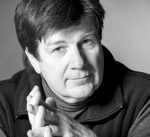
David Swift was a gifted photographer and one of the most interesting men I’ve even known. I met him decades ago in his beloved Jackson, Wyoming, but Swift loved to come south to warm up in the Spring. He became an early supporter of The Zephyr and noted that we, “print columns by boneheaded radicals as well as the radically boneheaded.”
David became one of the those bone-headed radicals on several occasions, including this brilliant essay on the joys of living in Hanksville, Utah. When he died suddenly, almost two years ago, the community of Jackson was shaken to its core. The ranks keep thinning. We keep losing the good guys…JS
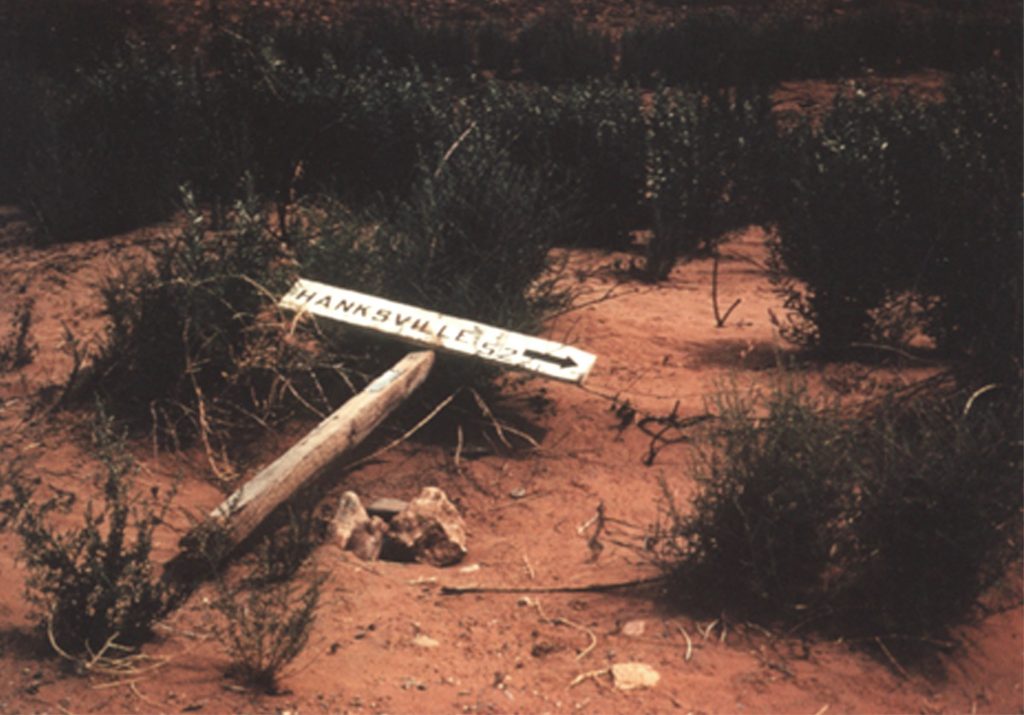
Hanksville makes tourists feel really good about themselves. This is done not by commission but by omission.
If you’re a divorcée from Lehl hauling your kid into Little Wild Horse Canyon for your Singles Who Mingle weekend getaway, one glance at Hanksville makes you think, “Even if the Micron factory isn’t opening until 2035 at least I’m not stuck here.”
If you’re from Des Moines and you’ve been hearing from under your RV’s hood the ol’ death-rattle—the pinging of octane-deprived Four Corners gasoline—as you clambered out of Hite Marina, you’d stop at the Hanksville Texaco. Lance Wells would check the vacuum advance hose, tweak your timing, say pleasant things, and charge a fair price. You’d motor off to Capitol Reef wondering, “Why would a nice guy like that live in a place that turns green for three hours a year?”
Or maybe you’re in a 4Runner and finally, after all these years, decided Moab was too crowded for your hep self…oh, never mind. You don’t have to gaze at Hanksville’s perennially scrubby landscape to feel superior. You already feel superior no matter where you are.
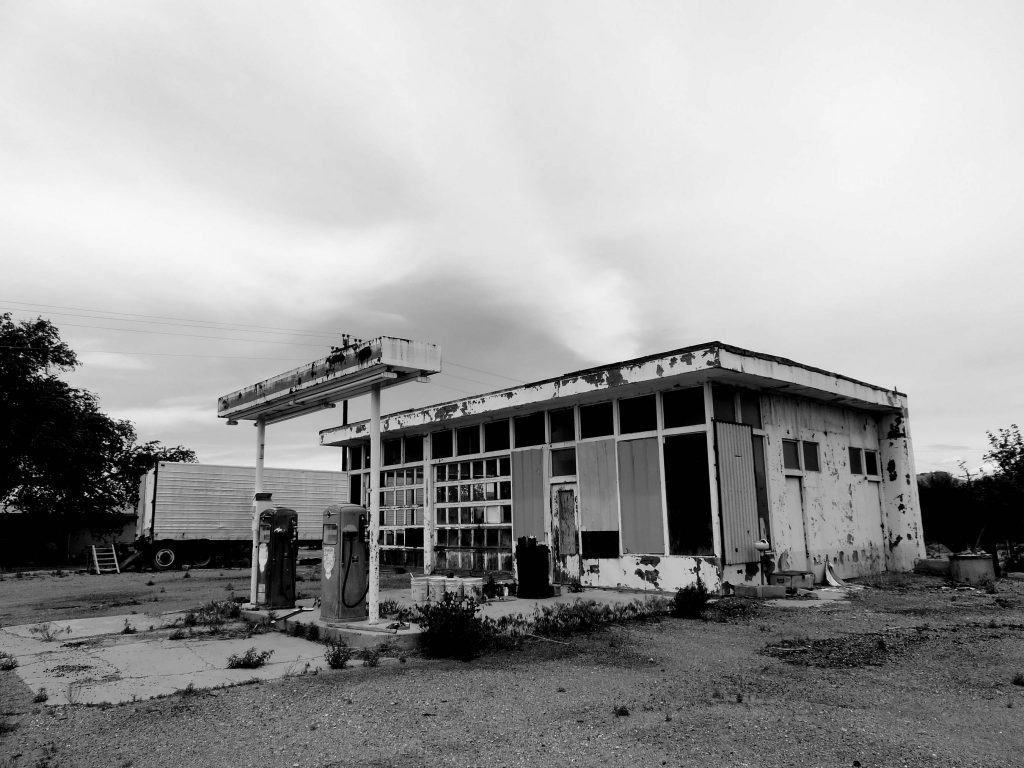
In a corner of the country that is mostly remote, Hanksville isn’t romantic-resort remote. It’s desolate. It’s “you came how far to announce you’re in the boonies?” remote. It’s where Butch Cassidy stayed his lostest until Bolivia, where pioneers happily laid down in the sand to die under a watchful sun because anyplace else was too far to go.
Ebenezer Hanks had his reason to choose remote. He didn’t feel like doing his mission and he did feel like having two wives. He settled what was known as Graves Valley 115 years ago. His teenage wife Sarah, wife no. 2, was nearly finished brooding their 10 children.
Alas, poor Ebenezer, not yet 50, hurt himself building a barn and died in 1884. By 1895 they named his settlement Hanksville. The place has been occupied by not very many people ever since. Hanks’ tombstone, handsome as can be, is still in place.
Boom towns have an unmistakable look of having seen better days. Hanksville does not have that look; that’s meant as a compliment.
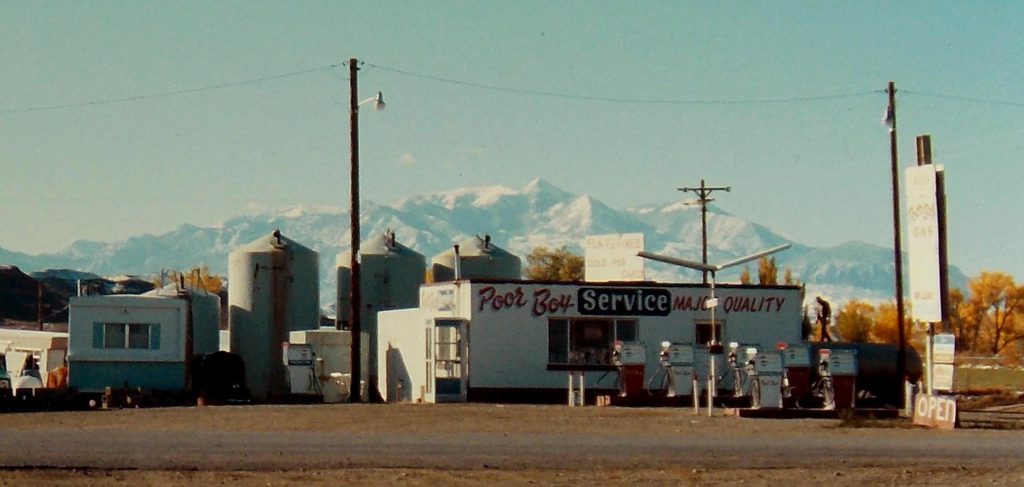
As Utah mining towns go, Hanksville appears sturdy and calm even if, say, the peeling Poor Boy Motel opens and closes depending on the latest management scandal.
There was a bit of a boom but not much. Its population was double, perhaps triple during the uranium heydays of the late 50s through early 70s. Around 1972, historian Barbara Ekker says, registered voters peaked at around 500.
The 1990 census says Hanksville has 353 residents. Ekker said she counted 229 in April 1996. The signs on the ends of town say POP 150.
Numbers notwithstanding, Hanksville is quiet. To the ears. Not so the eyes. Its pioneer tradition makes Hanksville appear to be in utter shambles. There’s something sacred about anything that used to roll. No car, truck, houseboat, or farming implement will be hauled off when there’s a slight chance it might resurrect itself.
Junk everywhere and a lack of trees is what distinguishes Hanksville from the rest of its Wayne County companion burgs.
Wayne is one of our nation’s weirder-shaped counties, a tilted rectangle 110 miles east-to-west and 25 miles north-to-south. Let’s drive Highway 24 to Hanksville from Loa, county seat. We’re up-county, as they say in Hanksville, in cool fertile farming country.
Twenty miles of this and we’re in Torrey, lovely and recently mugged by developers. The landscape turns rugged, becomes Capitol Reef National Park, and both Fremont River and the asphalt of State Route 24 hack through its sandstone layers.
Suddenly we’ve dropped down the east face of Waterpocket Fold, an astonishing geologic feature too big for most to notice. The landscape turns arid. Mud hills. Flat, featureless valleys. Sculpted rock, yes, but drained of color.
Save the Luna Mesa Cafe, a story unto itself, it’ll be 40 miles of this not-muchness until you see civilization in the form of Hanksville.
It’s been 66 miles and 3000 vertical feet down since Loa. “You’re either in Hanksville or you’re in Wayne County,” is how Jack Wilkins put it.
This geographic separation is a sore point because no one in Hanksville thinks they get a fair shake from the rest of the county. If you’re going to get sick or have a chainsaw accident in Hanksville, you better do it between 10 and 2 on Tuesdays.
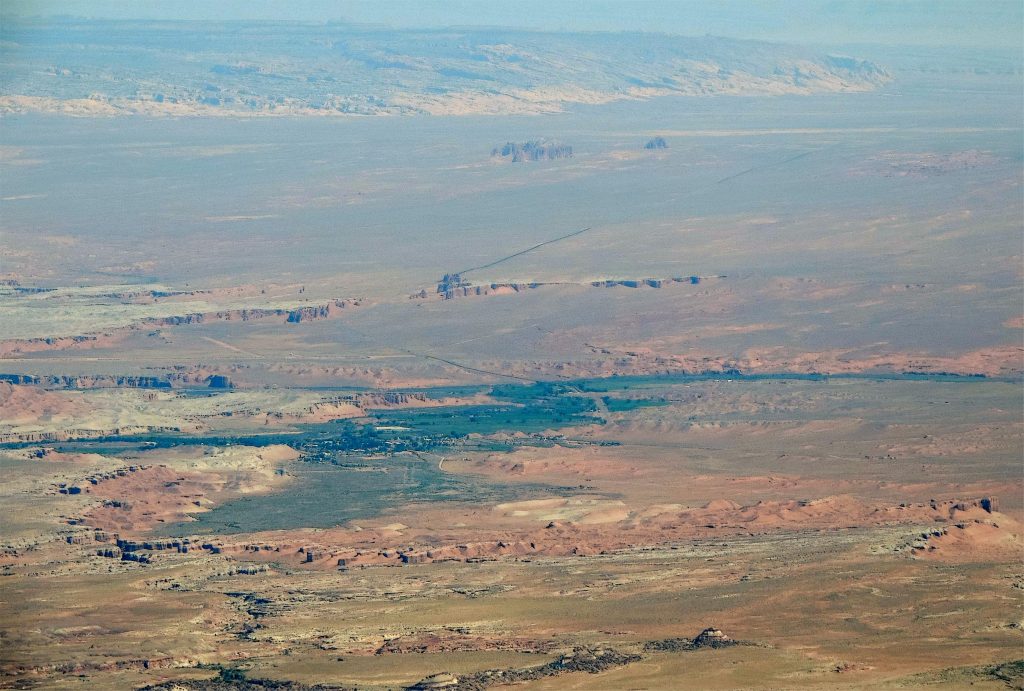
Meanwhile the county puts constant pressure on Hanksville to incorporate, to get its own police and fire department. No way. Too expensive.
Feeling shorted on services, it’s impressive that Hanksvillagers have accepted recent Wayne County planning regulations. There were the usual howls from the anti-Trilateral Commission contingent; any hard-scrabble survivor would think the world was coming to an end if you can no longer build, rewire, or plumb without hiring a licensed practitioner and getting inspections.
Not only does this send expenses through the roof but, in the real world, it means the work won’t get done. Legally, anyway. Licensed workers have to travel from Torrey and beyond. And they won’t, because of massive development close to home.
Being the county commissioner from Hanksville has not made Stan Alvey any friends, but he’s a realist. (I can’t believe I wrote that. The man has a pet buffalo.) “It’s a mess, what they’ve done in Torrey,” he says. “They’ve built houses in places you could never get a fire department to.”
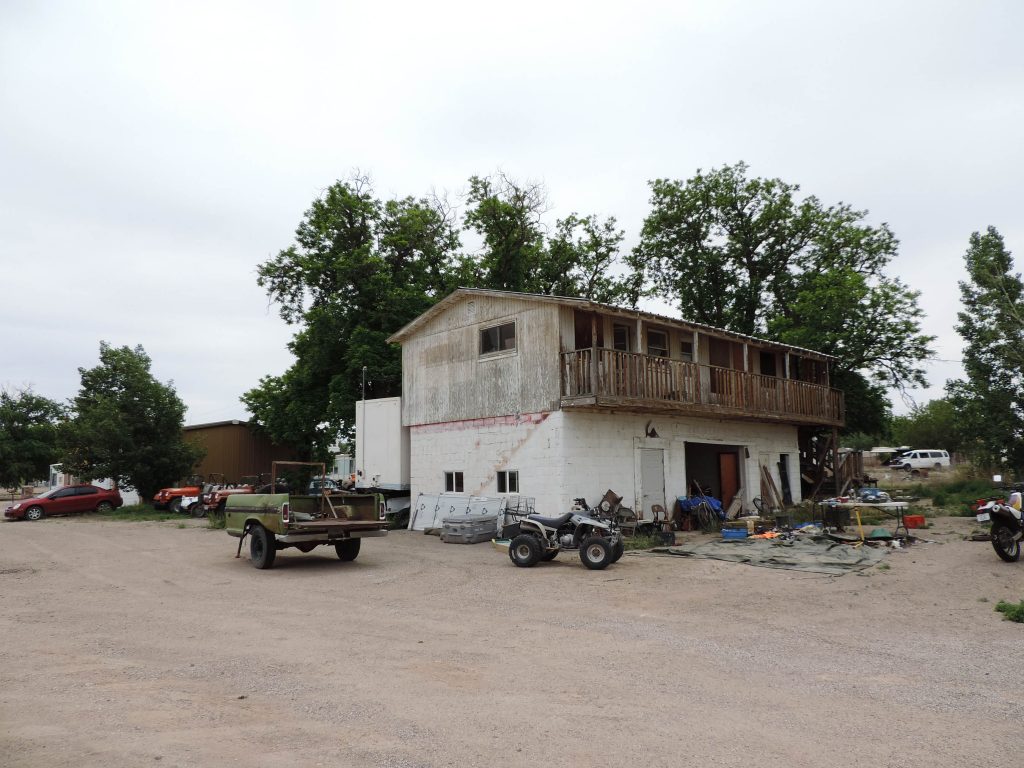
If Hanksville sounds too backwoods for you, and I hope it does, its leaders are in fact heads-up. Hanksville is the first town in Wayne County to have its own sewer system. There’s a town water system. Every kid at Hanksville Elementary has access to a sporty Macintosh computer connected to a full-time 56k internet line.
A committee has arranged to crush and haul junk cars, paying the owner $50 a ton. If you want to keep your junk cars, they’ll build a fence for you and paint it. They plant trees.
I hesitate to report that the median household income in 1989 was $20,833 because there’s no way you can call this a poor town. Folks here are self-sufficient and for the most part appear to be doing fine.
Take Curtis Whipple and Dan’l Lindsay, two family men in their 30s. They stayed busy as builders, plumbers, electricians, and all else, until the county regs kicked in. They narrowed their jobs to stay legal, are seeking proper credentials, and stay as busy as ever. Curtis is a scout leader and helped organize the car-crushing town cleanup committee. Dan’l is in constant demand from Torrey to Bullfrog.
They have seven kids between them and could probably use every penny. But they instinctively see a bigger picture. After Dan’l brought us a perfectly good refrigerator that was thrown out by a new Torreyite we practically had to staple a few bucks to his chest.
I look up Curtis for a breaker switch or a PVC elbow. I can’t pay him for stuff. I’m new in town, they don’t owe me a thing, but it’s an expression of what Hanksville is: a community.
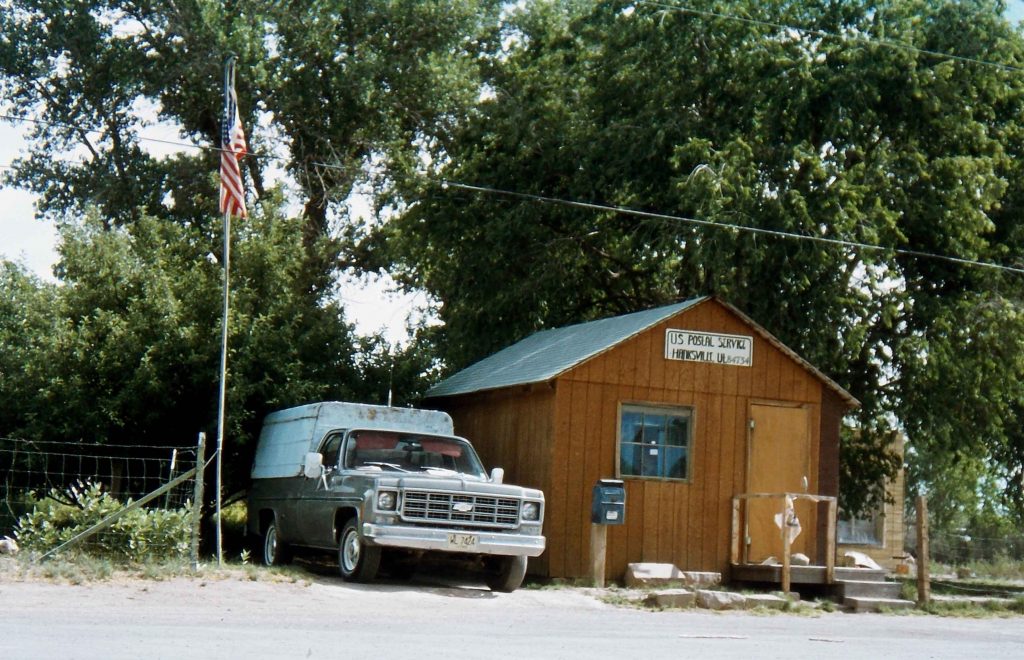
The next wave of community, to be exact. Just before I finished this article came word that Blondie’s, one of three Hanksville eateries, had a fire. A smoke, actually.
A new hire closed up and, instead of turning one burner off, turned three burners on. The smoke got so dense that it smothered the flame, so at least the building didn’t explode like it could have. Volunteers have been scrubbing down walls for days on end so Blondie can get back online while the high season remains.
Hanksville appears to be the only town in southern Utah that’s not growing like Martian sponge pods. Could Hanksville’s junkiness, treelessness, remoteness and scrubbiness be its saving grace?
It has more in its favor. There’s no apparent coalition of embittered farmers who would sell out as soon as Forbes and The New York Times Sunday Magazine “discover” how pretty the Dirty Devil looks at sunset with a gaudy red filter over the lens.
Furthermore, as Stan Alvey points out, most of the surrounding land is BLM. There’s not much private land to sell. Downside: if a feeding frenzy starts, this exclusivity causes prices to skyrocket. Upside to downside: we own a bit of this potentially-precious land.
But for now Hanksville is in good hands. It’s a simple, unpretentious place. If there is one local habit it seems to be enjoying the moment. The youngsters who rollerblade to the elementary look alive, fearless. Like their parents, Hanksville kids seem brighter than outsiders dare suspect.
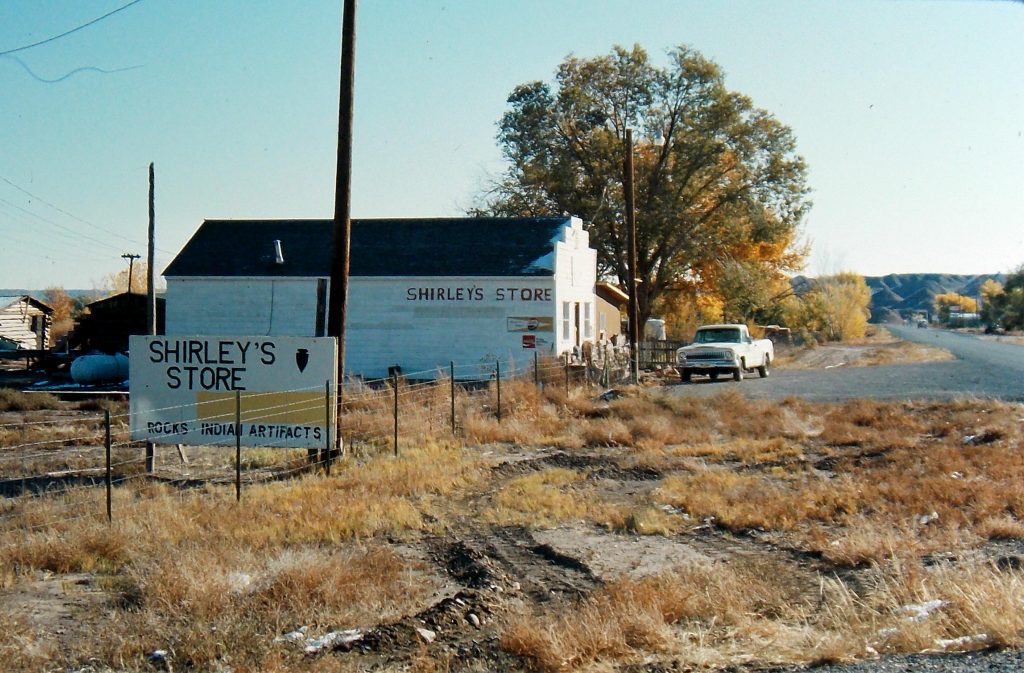
It took me a while to stop seeing the junk cars. Come to think of it, those piles aren’t far removed from the niftiest sculpture in Utah, Paul Turner’s splendid Monster Museum at Carl Hunt’s Desert Inn Motel.
Then there’s the nifty recursion you can only get in a small town. I’ve mixed little with townsfolks. Two incidents:
- When we bought a house in Hanksville a year ago, the real estate agent swore it was hooked to the town sewer. This may shock you, but our agent was not telling the truth.
- Last fall we found a shortcut we’d been looking for, where Muddy Creek cuts through the San Rafael Reef. Before long the rear differential was under quicksand.
Shortly after we moved into the house Sam Wells built right after World War II, Don Wells comes by one day to tell us the story of his father’s work. He points to the initials DW on our back porch, scrawled by Don in wet concrete one year before I was born.
Later he comes back and says, um, by the way, this house is not on the town sewer.
“Sure it is. The agent said so.”
Done has very blue and very correct eyes. I felt like an idiot and hoped for the best.
Months later, my truck is raised on Lance’s rack—he owns the local Texaco, remember. Lance was nice enough to squeeze me in so I could drain the sandy, watery oil from my differential. He welcomes me to the biggest club in Hanksville. Everyone has sunk their rig in the same spot in Muddy Creek.
Lance Wells’ wife Lisa is the secretary of the sewer board. I have to call Lisa since, over the winter, the lid to the septic tank caved in, revealing the truth in what Don said.
At this point, I wriggle in discomfort with an ethical dilemma. Should I tell the truth about Hanksville, or tell a larger truth?
The truth is, Hanskvillians are doing just fine. Spendy gorpster traffic is minimal—the Moab side of the canyonlands enjoys that bounty—but Hanksville makes decent dough feeding, gassing, and beering legions of Lake Powell boaters. Miners, farmers, and cattlemen get the same beating here as they do everywhere else.
The larger truth is—and after you read this I’ll have to kill you—the Hanksville style of remoteness is quickly becoming precious and therefore a marketable commodity. Between clean phone lines and FedEx, any desk jockey can make a living anywhere. Hanksville is going to be an Anywhere someday.
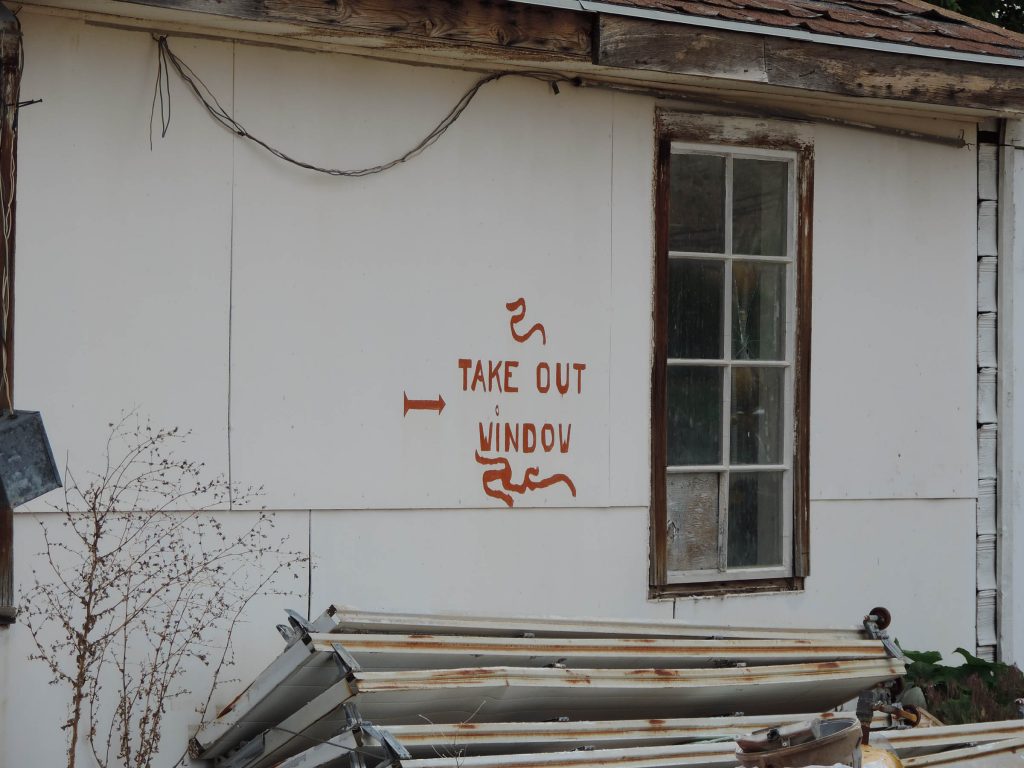
Perhaps Hanksville’s saving grace is the trompe l’oiel aspect of the landscape. It looks blightish. Few trees, a lot of cars, and an astonishing number of beater houseboats.
Its outskirts have little in the way of postcard beauty. The Burr Desert to the south is scrub, scrub, scrub. The Henry Mountains so named not because of a play on “Hanks” but after a D.C. Bureaucrat, are seldom considered a tourist destination save by true adventurers and the occasional red-blooded soul who needs to shoot the easiest target in the West, the wild bison.
The sprawling, little-explored San Rafael Swell to the northwest is too distant from the highway and too inaccessible road-wise to give tourists the national park-like beauty buzz they demand.
The surrounding landscape in general has that Cedar Mesa phonomenon: there’s no there there.
It’s an illusion. Just outside your Hanksville-oriented field of vision is a lifetime of wonderment and mineshafts, wide road grading for all eternity leading to pucker-power switchbacks, lunar mounds the color of an eclipse, places where you would not mind lying down to die under a watchful sun.
For 25 years some guy in the Hanksville cemetery has been happy under the ground with nothing for a tombstone but a quarter-inch plywood plank cut by hand with a coping saw. Living in Hanksville means being that confident in life.
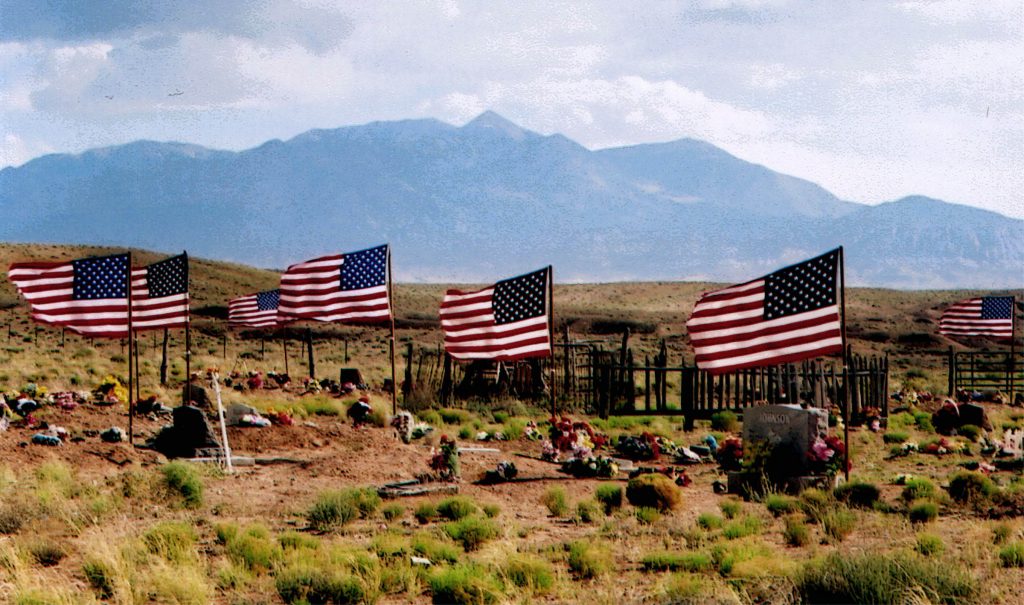
To comment, scroll to the bottom of the page.
Zephyr Policy: REAL NAMES ONLY on Comments!
Don’t forget about the Zephyr ads! All links are hot!
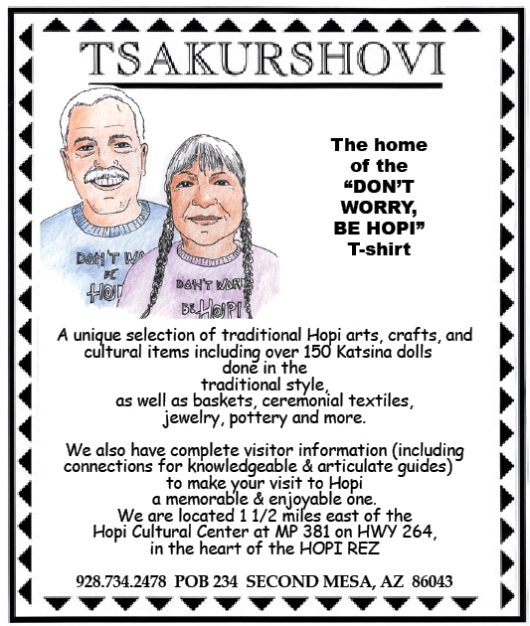
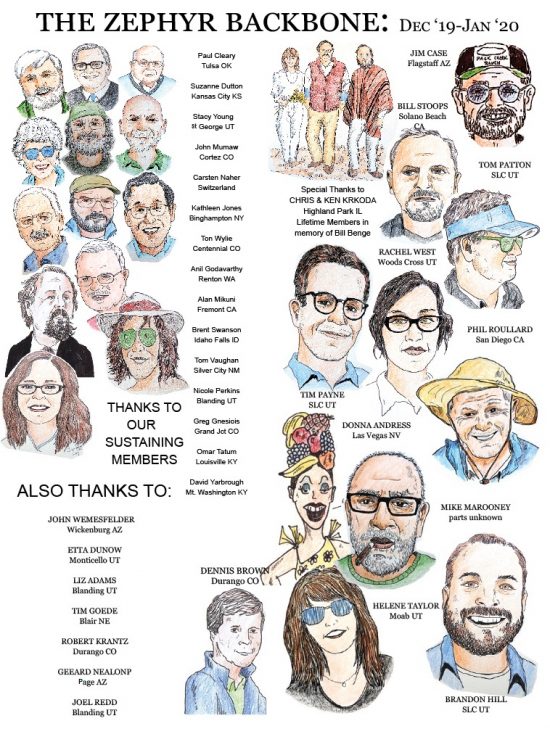


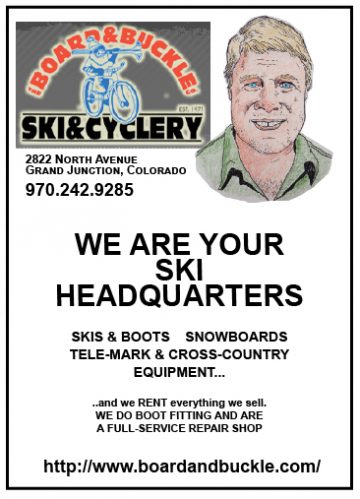


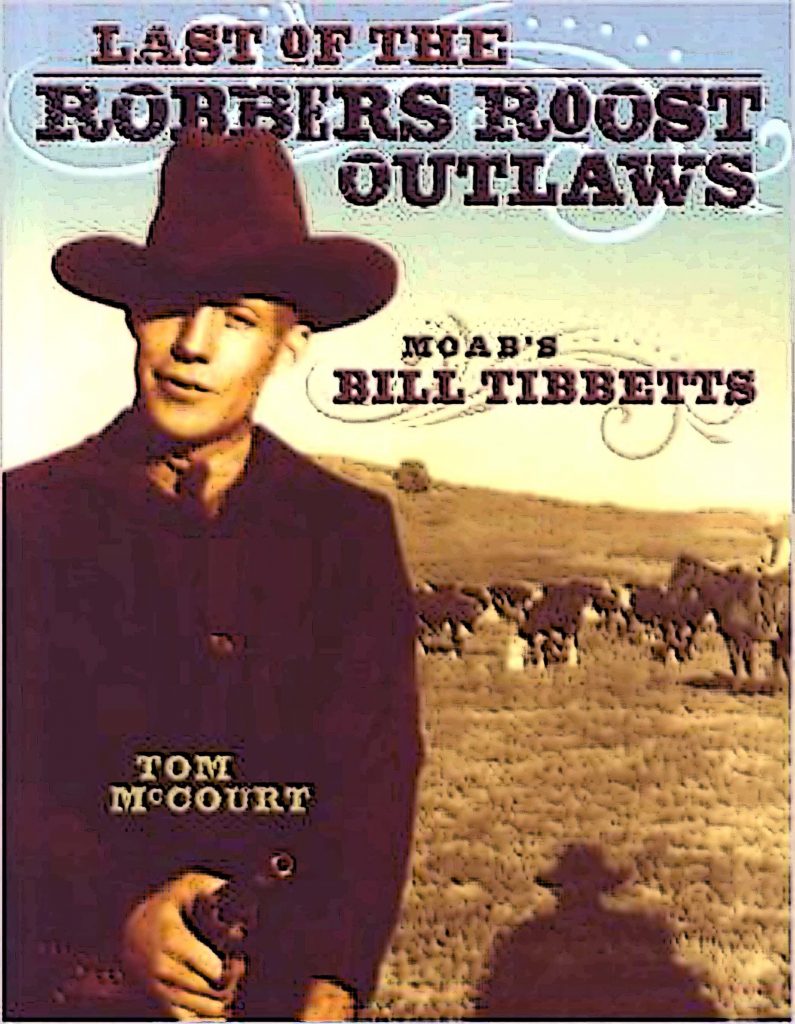
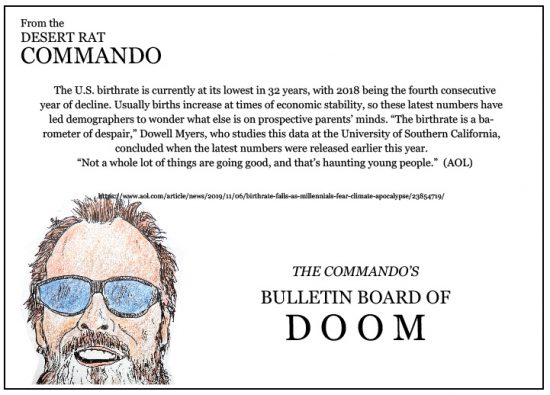

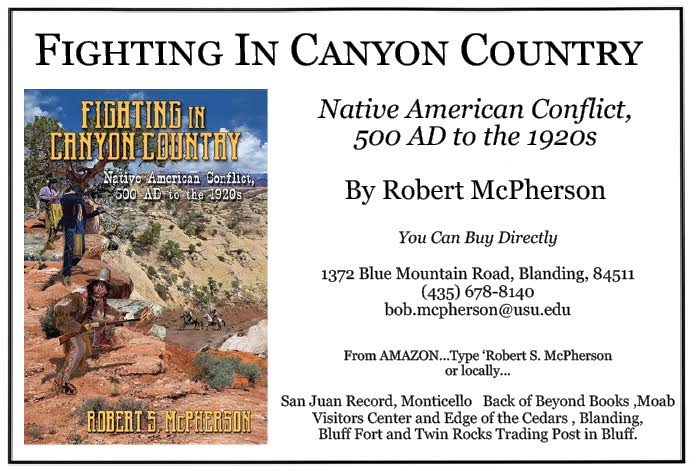
Nice article….I love Hanksville and it’s surrounds!! My go to place.
gw
Stiles—thanks for re-running this. Makes me remember how much I miss David’s writing. For the curious, and from some comments in the text, this would’ve been written in 1998.
I really enjoyed reading this. Thanks for writing it, David. Miss you. Thanks for pointing it out.
I used that muddy creek crossing lots of times. Never stuck a vehicle but I stuck my six year old son. He was walking across and sunk to his waist in quicksand. Took me awhile to get him out. Pulled on him so hard his knees hurt for two days!!
By the time of the original writing, Hanksville should have been known for the hour long traffic jam, while the Utah Highway Patrol courteously performed their D.U.I. Check points. These check points took so long on the weekends , you had to stop at the gas station, purchase a six pack and throw down a couple before moving on. (Just joking but it did seem like forever in the summer heat). And of course Hanksville should be known for that third leg of your student pilot cross country, Huntington, Grand Junction, Hanksville, and back, if you didn’t get lost or shear off some tree tops.
Jim, I have driven through Hanksville a few times and stopped every time for gas and/or a visit to the in-the-rock store. Your photos add so much to some very good prose. The prose is a nine, the photos are a ten and together they add up to 100. Goblin Valley State Park is not mentioned in the article. It is a great place to visit and not that far from Hanksville.
You forgotten it is a Rock Hounds dream, I visit about 3 times a year just to go rock hunting. Love Hanksville
My ancestral roots grow deep in Hanksville. Settled by my great-great grandfather, Ebenezer Hanks, its history is much more than booms, busts, and tourist curiosities. It’s ongoing family lore.
Great article!
You have to love long vistas and desert skies to “get” Hanksville and we do.
I dont quite know how to take your article. I have lived in Hanksville since 1969, there have been good times and hard times. (I could go political now but I wont) . If you dont look at the junk cars, and by the way there are plenty of trees, and the shabby buildings, that have alot of history , I’m glad they are still there. Just look up! People come from all over the world to enjoy what we have, the desert is beautiful, the canyons and red ledges, nothing more beautiful than the Herny mountains, San Rafeal, Goblin
Valley, I could go on and on. The cemetery, I just purchased plots for my husband and I, and I am so happy to know that that will be my final resting place.
Fun read. I was more than likely one of the local kids you wrote about here, rollerblading without a care in the world, yet knowing more than the world wanted to accept I knew. A man drove through one summer and asked me a bit about my life there while I was making his lunch. I told him what I could articulate at fifteen. He said, “You should write a book. No one has a childhood like this.” I got out of that town as fast as I could, explored the world, finally became a writer, and my favorite thing to write about to this day is that unknown desert home that still inspires me in more ways than someone driving through could ever understand. Raising kids in a busy city has opened my eyes even more to the magic of the quiet a town like Hanksville provides for its residents. You’ve gotta be tough as nails to endure a place like that and being wise helps you see the beauty beyond the broken buildings. The best watermelon I ever had came out of that ground; best tomatoes, too. To this day I find something new to be awestruck by when I visit. You either get it or you don’t, and lucky for me I do.
Great article, I enjoyed re-reading it. I lived in Hanksville from 1978-1982 working for, gasp, the BLM! Even though working for the “enemy”, I and my family felt part of the community. I then left for the bright lights of Moab…. I would take Hanksville in a nanosecond over the industrial scale recreation and liberal mess that Moab has become. The Henry Mountains are still my favorite place on the Colorado plateau, and I hope they are never “discovered”.